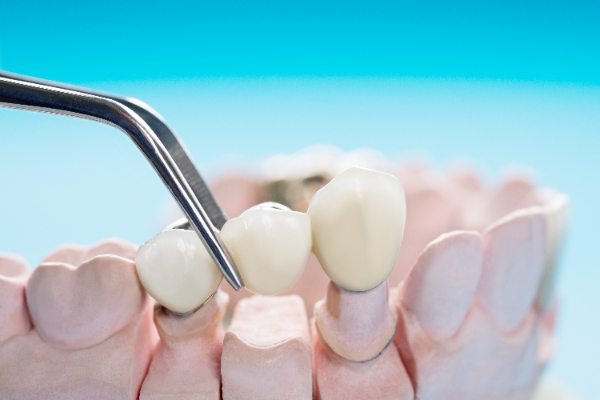When Is a Dental Bridge Recommended to Replace Missing Teeth?

A dental bridge, sometimes described as fixed partial dentures, is a type of dental restoration that replaces one or more missing teeth. Dental bridges are made of porcelain or other materials. The tooth or teeth on either side of the gap are prepared to receive crowns and false teeth (known as pontics). The false teeth are then attached to the crowns. This creates a new structure that resembles a natural bridge, replacing your lost teeth or tooth. A dental bridge can restore your natural appearance and improve your chewing ability. They are also good for preventing bone loss in the jawbone after a tooth or teeth loss.
The need to replace missing teeth
Replacing missing teeth is good for oral health. However, due to the cost of dental restoration, many people delay replacing missing teeth. Unfortunately, the delay worsens the problem, potentially increasing the cost of tooth replacement. Some side effects of untreated tooth loss include gum disease, shifting of adjacent teeth, jawbone deterioration, TMJ pain, and uneven biting power.
When a tooth is missing, the surrounding teeth can shift. The shift may cause the person to have an improper bite, which in turn can cause them to be at a higher risk of breaking another tooth. The other teeth may also become loose and fall out, or even worse, they may become so misaligned that they begin affecting how the patient’s jawbone fits together.
In addition, the shift of the remaining teeth can lead to speech problems and chewing issues. Since we use our teeth to help pronounce certain words, missing one or more teeth can subtly affect how a patient speaks. Since a missing tooth or teeth affect the way the patient’s jaw functions, it can then start a domino effect and negatively impact how the muscles work during chewing and swallowing.
How dental bridges work
A dental bridge bridges the gap between the teeth. A dentist will use healthy teeth on the side of the gap to support the bridge securely. A dental bridge is mostly recommended when a patient still has healthy and strong teeth to support a replacement. The bridge consists of two parts: the permanent tooth to cover the space and dental crowns that cover the existing teeth. Depending on the number and position of missing teeth, the dental bridge may have more than two crowns and replacement teeth.
Dental bridges look and function like natural teeth. Unlike dentures, they are fixed in place. Patients will be able to eat, smile, and talk as usual without worrying about the appearance of their smiles. The bridge is produced from biocompatible materials, promotes gum health, and slows down the rate of bone loss.
Getting a dental bridge
A person with missing or damaged teeth needs to book an appointment with a dentist for a consultation. The dentist will examine the teeth during the appointment and review possible options. When only one to three teeth are missing consecutively, a dental bridge is one of the most effective options for tooth replacement. Also, the nearby teeth (called abutments) that will support the bridge need to be healthy and have a good root system. The success of the dental bridge relies on how long the abutment teeth hold up.
If the patient is ready, the dentist may begin the preparation process for the bridge at the first dental visit. The adjacent teeth will be scraped for the incoming crown, and impressions will be taken. The impressions ensure the final bridge fits perfectly in the mouth. The dentist will provide a temporary bridge to protect the teeth during the production of the permanent bridge.
When the final bridge is ready, the patient will return for another appointment. The dentist will remove the temporary bridge and bond the new dental bridge into place. Then, they will examine it and make necessary adjustments to ensure a comfortable fit.
In conclusion
In some cases, a dental bridge may be recommended as an alternative to dentures if the person has lost teeth due to trauma or disease. Dental bridges provide function and an aesthetically pleasing appearance for people who have lost one or more teeth, but they differ in terms of their placement and durability. In addition, not seeking care for missing teeth can lead to more severe problems such as misalignments, crowding of your teeth, damage to the remaining teeth, and more.
You must visit a dental office if you have had missing teeth for a while or recently lost them. Our dentist will recommend the most effective option, which could be a dental bridge, to restore the function and appearance of your smile.
Diamond Head Dental Care offers dental bridges as effective treatment options for those experiencing the loss of their teeth. To determine if you are an ideal candidate for this treatment option, call our Pearl City office at (808) 214-9287 to schedule an appointment. To learn more about our services and process, visit https://pearlcity.diamondheaddentalcare.com.
Check out what others are saying about our dental services on Yelp: Dental Bridge in Pearl City, HI.
Recent Posts
The dental bridge procedure is a tooth replacement option. The bridge covers the gap between the teeth using the healthy teeth present on either side, consequently restoring the function and appearance of the teeth. This article outlines what happens during a dental bridge installation.The first step in the dental bridge procedure is to determine the…
In some form, dental crowns have been a part of dentistry for centuries. This treatment is an important restoration method for people who have severe tooth decay. Cosmetic dentistry also uses crowns to improve patients’ smiles. If you are unhappy with the appearance of your teeth, a crown could be the right solution. Your dentist…
Anyone who has had dental crowns understands how beneficial they can be. Crowns are highly durable and work to improve the look of teeth, restoring a person's smile. A crown is often used to prevent a damaged tooth from deteriorating further. Others may need a crown to complete a bridge or implant treatment. A dental…
When teeth are severely decayed or damaged, dental crowns may be able to restore them so they do not have to be extracted. Dentists prefer to leave natural teeth in the mouth whenever possible. A crown is a cap placed over a damaged tooth, restoring its original function, appearance, and strength.Placing a crown traditionally requires…


